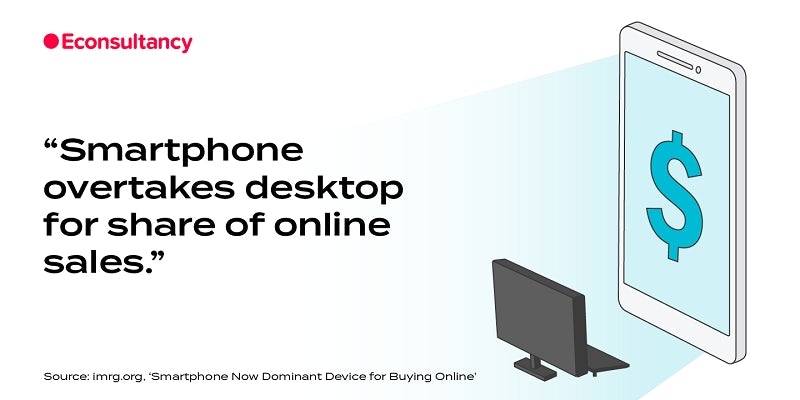This week’s includes news about online sales, marketing budgets, data privacy, and lots more. Head on over to the Internet Statistics Database, too, as it’s full of further stats and insight.
Smartphone overtakes desktop for share of online sales
According to the latest Capgemini IMRG figures, smartphone has overtaken desktop’s share of online sales for the first time ever, making it the most dominant device for buying online.
The share of sales revenue through smartphone devices reached 40.4% in Q4 2018/19, with desktop trailing behind at 39.7%, and tablets at 19.9%. In December 2018, smartphones accounted for over 70% of mobile device sales for the first time (the other 30% was spent through tablets).
People are also increasingly using mobile to browse retail sites (and not necessarily buying). Back in 2015, the percentage of visits to retail sites through smartphones and tablets versus desktop was fairly even. This has dramatically changed, however, with 74.3% of retail site visits being made through mobile devices in Q4 2018.

87% of marketers have a dedicated budget for testing new technology
The DMA’s Future Trends report has revealed that 87% of marketers have a dedicated budget for testing new technology.
On average, 36% of company budgets are allocated to trialling new technology, with just 13% of organisations not having the funds in place to test the latest innovations. The research also revealed that the size and resource available to a business seems to have a direct impact on budget allocated, with just 18% of small firms able to invest compared to 38% of medium-sized organisations and 37% of larger companies.
In terms of future investment, marketers state that the most popular use for marketing budgets in the next five years includes finding new ways to ‘chat’. 36% said this would be with humans, while 37% said this would be investment in chatbots. 54% says they already use and will continue to use chatbots, and this figure will likely increase over time.
A Guide to Digital Marketing Tools
Half of UK shoppers buy on Amazon at least once a month
According to Global Data, 51.4% of all UK shoppers make a purchase from Amazon at least once a month.
Amazon’s UK revenue rose 23.3% in 2018, proving that the retailer shows no signs of slowing down. Indeed, GlobalData says that Amazon’s share of UK retail spend (including third-party sales) increased by 0.7% to reach 4.9% in 2018, with rapid growth forecast over the next five years, and the retailer set to account for 8% of spend by 2023.

71% of Brits believe that tech companies record data via phones and laptops without consent
In a YouGov survey of 1776 UK consumers, 71% of respondents said they believe that tech companies record our data without consent via phones and laptops. As a result, four in 10 cover up their webcam, 18% do so on occasion, and 21% say they always do.
When asked whether they think tech companies record us without consent, 71% of respondents said they think they do, and 56% said they think it’s a problem. Interestingly, 25% of people who do not think this is the case still cover up their webcam just in case.
In terms of other precautions, 64% of respondents say they adjust privacy settings on their devices to make sure they’re not giving away data they don’t want to, 38% always deny permissions for data collection on apps, and 5% always browse the internet in incognito mode (39% do so on occasion).

Trust, Transparency and Brand Safety
Mobile ads trigger an imprint in the brain in less than half a second
New research by the Marketing Mobile Association aims to understand how consumers process information in a mobile environment.
It found that the human brain needs less than half a second to engage with mobile advertising and trigger an imprint, whether a positive or negative one. More than 67% of the ads tested in the study were already seen and cognitively recognised at 0.4 seconds. In comparison, the MMA found that it took two to three seconds for two thirds of desktop ads to be seen and cognitively recognised.
Meanwhile, video was found to better engage the emotional brain. While static and video ads have the same likelihood of being seen, video ads are twice as likely to create emotional response than static in faster exposure speeds, being recognised in less than 0.7 seconds.

Conversion rates for fashion retailers in the UK higher than global average (but average order value is less)
A new study by Nosto has found that UK fashion retailers are succeeding in converting online traffic into sales. Based on an analysis of 1.2 billion visits to fashion ecommerce websites globally, Nosto found that UK fashion ecommerce sites have conversions rates of 1.6% on mobile and 2.9% on desktop – higher than corresponding global rates of 1.3% and 2.4% respectively.
What is a good ecommerce conversion rate?
Despite this, however, it appears that UK shoppers are still low-spend compared to other markets. UK consumers spend 27% less on orders placed via mobile and 32% less on desktop orders compared to the global average.
Elsewhere, Nosto found some interesting differences in shopping habits for different markets. For example, French shoppers have the longest visit times on mobile (186 seconds), which is more than 20 seconds longer than the global average of 164 seconds. Finally, Austria, Germany, and Switzerland have the lowest cart abandonment rates on both mobile and desktop, which is 73% and 66% (compared with corresponding global averages of 80% and 74%).


Comments